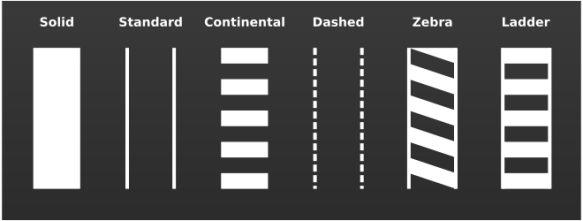Marked crosswalks are an essential tool for helping pedestrians move safely, conveniently and predictably across roadways. Crosswalks can also provide a unique streetscape design treatment to emphasize pedestrians’ presence and primacy.
Marked crosswalks alert drivers to expect crossing pedestrians and to direct pedestrians to desirable crossing locations – marking crosswalks at every intersection is not necessary or desirable. Although many motorists are unaware of their precise legal obligations at crosswalks, the California Vehicle Code requires drivers to yield to pedestrians in any crosswalk, whether marked or unmarked.
Streetscape design should emphasize crosswalks as a fundamental part of the pedestrian realm, not as an intrusion into the roadway reserved for vehicles only.
Process Overview
The San Francisco Municipal Transportation Agency (SFMTA) oversees the installation and maintenance of crosswalks in San Francisco. Mid-block crosswalk installation and crosswalk removal require a public hearing and legislative action by the SFMTA Board.
Individuals or community groups interested in installing or improving a crosswalk in their neighborhood should call or go to 311.
Once a request has been submitted, a San Francisco Municipal Transportation Agency (SFMTA) inspector will evaluate the proposed location. If the location meets design criteria, SFMTA will issue a public notice soliciting feedback on the proposed crosswalk and inviting interested community members to a public hearing at the SFMTA board. If the SFMTA Board approves the crosswalk improvement, the SFMTA will install the crosswalk as schedules and resources allow.
Contact SFMTA Livable Streets for more information about crosswalks
Official Codes & Documents
- Better Streets Plan (street design guidelines)
- SFMTA Crosswalk Guidelines (May 29, 2014)
Design Guidelines
Placement
Contact SFMTA Livable Streets for more information on appropriate locations for marked crosswalks.
Street types: All
Sidewalk zones: Roadway
Crosswalks are present by law at all approximately right angle intersections, whether marked or unmarked, unless the pedestrian crossing is specifically prohibited. At midblock locations, crosswalks only exist where marked. At these non-intersection locations, it is the crosswalk markings that legally establish the crosswalk.
The decision to mark a crosswalk should not be considered in isolation, but rather in conjunction with other measures to increase motorists’ awareness of pedestrians. Without additional measures, marked crosswalks alone are unlikely to increase pedestrian safety and may decrease safety, particularly on multi-lane streets.
Controlled Intersections
Intersections can be controlled by traffic signals or STOP signs. Per existing City policy, marked crosswalks should be provided on all intersection legs controlled by traffic signals, unless the pedestrian crossing is specifically prohibited. Crosswalks may be considered at all STOP-controlled intersections.
Factors to be considered include: high pedestrian volumes, vehicle volumes, school zone location, substantial volume of elderly or disabled use, or other safety reasons.
Uncontrolled Intersections
Intersections without traffic signals or STOP signs are considered uncontrolled intersections. The decision to mark a crosswalk at an uncontrolled location should be guided by an engineering study.
Factors considered in the study include vehicular volumes and speeds, roadway width and configuration, stopping sight distance, distance to the next controlled crossing, night time visibility, grade, and pedestrian volumes.
High-Visibility Crosswalks
Because of the low approach angle at which pavement markings are viewed by drivers, the use of longitudinal stripes in addition to or in place of the standard transverse markings can significantly increase the visibility of a crosswalk to oncoming traffic. While research has not shown a direct link between increased crosswalk visibility and increased pedestrian safety, high-visibility crosswalks have been shown to increase motorist yielding and channelization of pedestrians, leading the Federal Highway Administration (FHWA) to conclude that high-visibility pedestrian crosswalks have a positive effect on pedestrian and driver behavior.
Various crosswalk marking patterns exist in San Francisco, including continental, transverse, and ladder, as shown below. Until recently, San Francisco used continental markings only at mid-block and school area crosswalks; it is now the goal of the SFMTA to gradually have all crosswalk markings be converted to the high-visibility continental marking pattern. However, because it costs more to install and maintain continental crosswalks, this policy will be implemented slowly over time as resources allow.
Mid-Block Crosswalks
In areas with short block lengths, closely-spaced intersections ensure that pedestrians can easily find crosswalks without having to go out of their way, but many areas have long blocks with widely-spaced intersections and fewer crossing opportunities. Mid-block crosswalks may provide a convenient crossing for pedestrians when other crossing opportunities are distant, or where a destination creates high crossing demand.
Site-specific analysis and environmental clearance would be required for any proposed mid-block crossing to identify whether it would result in or contribute to unacceptable levels of service or delay to transit vehicles.
Contact SFMTA Livable Streets for more information on appropriate locations for marked crosswalks.
Design
Crosswalks should be at least as wide as the sidewalk, but may be wider in locations with high pedestrian demand or narrow sidewalks. Crosswalks should be no less than 10 feet in width. Crosswalks must be outfitted with curb ramps and tactile warning strips per federal accessibility guidelines. The California Manual on Uniform Traffic Control Devices (MUTCD) contains standards and guidance on crosswalk warning signs and supplementary markings.
Standard Crosswalks
The standard treatment for marked crosswalks at intersection locations consists of two 12 inch-wide white retro-reflective thermoplastic stripes that delineate the sides of the pedestrian walking area. The stripes should be perpendicular (or transverse) to the direction of vehicle travel and parallel to the direction of pedestrian travel. School crosswalks must be yellow per state code; in San Francisco, school crossings should be given a yellow, continental crosswalk treatment.
High-Visibility Crosswalks
High-visibility crosswalks should be marked using the continental pattern of crosswalk striping, which consists of a series of wide stripes parallel to the curb for the length of the crossing. (These are distinguished from ladder crosswalks, which retain the transverse side stripes of the standard crosswalk in addition to the wide ‘rungs’ of the ladder, or zebra crosswalks, which have diagonal stripes.

High Visibility Crosswalk Treatments
When transverse markings are converted to continental markings, the side stripes may remain, since removal is costly, but the side stripes should not be maintained. To the extent possible, continental crosswalks will be designed with the stripes placed to avoid wheel paths, which can reduce long-term maintenance needs.
Mid-Block Crosswalks
Mid-block crossings should:
- Be enhanced through the use of signage, striping, signalization, or other special treatments such as flashing beacons, special paving materials, or raised crossings
- Be constructed in combination with mid-block Curb Extensions
- Include Pedestrian Lighting oriented toward the crossing
Supplementary Pedestrian Crossing Treatments
Advance Stop and Yield Lines
Stop lines (or limit lines) are solid white lines 12 to 24 inches wide, extending across all approach lanes to indicate where vehicles must stop in compliance with a stop sign or signal. Advance stop lines reduce vehicle encroachment into the crosswalk and improve drivers’ view of pedestrians.
On multi-lane roads, advance stop & yield lines can be an effective tool for preventing multiple threat vehicle and pedestrian collisions. SFMTA has developed guidelines for the installation of advanced stop lines consistent with the national guidance found in Section 3B.16 of the MUTCD, which allows for their use from 4 to 50 feet in advance of crosswalks, depending upon location-specific variables such as vehicle speeds, traffic control, street width, on-street parking, potential for visual confusion, nearby land uses with vulnerable populations, and demand for queuing space.
Yield lines are another option that can be used to reduce the possibility of multiple threat collisions at uncontrolled crosswalks on multi-lane roadways. They consist of a single row of white triangles placed across each approach to indicate the point at which vehicles must yield, and may be placed a minimum of 4 feet in advance of uncontrolled marked crosswalk locations.
Contact SFMTA Livable Streets for more information on appropriate design of advance stop and yield lines.
Flashing Lights and Beacons
In-roadway flashing lights are intended to call extra attention to pedestrians in crosswalks where signage or other design treatments are deemed insufficient. The flashers can be activated passively with infra-red or microwave detectors, or actively by pedestrian push-buttons. In San Francisco and elsewhere, in-roadway flashing lights have not performed well due to ongoing maintenance issues. In San Francisco, little or no effect on injury collisions has been discernible (for lack of collisions), but measurable increases in motorists yielding to pedestrians have been found.
Section 4L.02 of the MUTCD provides a list of factors to consider (including vehicle and pedestrian volume thresholds) when evaluating the need for in-pavement warning lights at crosswalks, as well as standards for their installation and operation.
If reliability can be improved, in-pavement flashing crosswalks should be considered at high-conflict uncontrolled crossing locations with posted speeds under 35 mph and significant pedestrian volumes that require extra visibility.
Flashing beacons can be used to control traffic at intersections where traffic or physical conditions do not justify a full signal but crash rates indicate the possibility of a special need, or to provide supplementary warning of a midblock or uncontrolled school crosswalk. They should be considered for use at high-conflict uncontrolled crossing locations with significant pedestrian volumes where visibility is compromised by grades, curves, or other conditions.
Chapter 4K of the MUTCD provides guidance for the use of flashing beacons.
Special Intersection Paving
Special intersection paving treatments can break the visual monotony of asphalt streets, highlight crossings as an extension of the pedestrian realm, and announce key civic or commercial locations. Special intersection paving treatments include integrated colors, textures, and scoring patterns. They may be instituted within crosswalk markings or across an entire intersection.
Special decorative paving, including colored and/or textured concrete, asphalt or pavers, or any similar treatment does not define a crosswalk and should not be seen as a safety measure. Standard transverse or longitudinal high visibility crosswalk markings are still required.
Special intersection paving treatments are more costly to build and maintain than standard treatments. Where capital and maintenance budgets allow, they may be considered on:
- Streets important to the city pattern
- Commercial streets
- At entries to residential areas where residential streets intersect with higher volume streets
- At key civic locations, such as civic buildings or entries to open spaces
- At mid-block crosswalks
Paving treatments should:
- Use integrated color, texture, and pattern. Potential materials include but are not limited to colored and stamped asphalt, poured concrete, and stone or concrete pavers
- Provide a surface that does not cause discomfort due to excessive vibration to those using wheelchairs or other assistive mobility devices
- Use stable, durable, and slip resistant materials
- Include edging treatments to visually contrast with the primary material and with the asphalt roadway
- Include crosswalk striping (parallel white lines) on the outer edge of the crossing
See SIdewalk Paving
Raised Crosswalks and Intersections
Raised crosswalks are a traffic calming strategy that brings the level of the roadway to that of the sidewalk, forcing vehicles to slow before passing over the crosswalk and providing a level pedestrian path of travel from curb to curb.
Pedestrian refuge islands
Crosswalks may also include pedestrian refuge islands to break up the crossing and slow cars.
Re-opening Closed Crosswalks
Crosswalks are present by law at all approximately right angle intersections, whether marked or unmarked, unless pedestrian crossing is specifically prohibited. In the past, crosswalks have been closed at some locations where limited visibility or high traffic volumes might endanger crossing pedestrians. Currently, there are roughly 100 closed crosswalks citywide where signage and physical barriers forbid pedestrians from crossing. San Francisco’s Better Streets Plan recommends that closed crosswalks be evaluated for opening in order to improve access and pedestrian network connectivity. This project is ongoing.
San Francisco has a number of closed crosswalks, creating discontinuous pedestrian paths of travel and making walking inconvenient. A primary motivation for closing crosswalks is to safeguard pedestrians in the face of very high traffic volumes or speeds and auto-oriented design, but many times pedestrians ignore crosswalk closures rather than crossing three times to reach a destination that could be reached by one illegal crossing, creating additional safety issues.
New crosswalk closures should not be instituted.
Existing closed crosswalks should be evaluated for opening. This may necessitate additional safety measures such as pedestrian actuation and signal timing changes. Reopening of crosswalk closures will require site-specific analysis and environmental review. At the time the study is undertaken, the effects of removal of crosswalk closure would be evaluated for its impact on the physical environment.
See also:
Vehicle Turn Movements at Crosswalks
Parking Restrictions at Crosswalks
Maintenance
Generally, the City is responsible for maintaining roadway paving and other features in the roadway, such as medians, roadway striping and crosswalks.
Construction crews working in the public right-of-way are required to replace in-kind any streetscape features like crosswalk striping damaged or removed during construction.
To report a maintenance issue with a crosswalk, call or go to 311.
For a more detailed description of maintenance responsibilities, see Maintenance.







 Copyright © 2015
Copyright © 2015